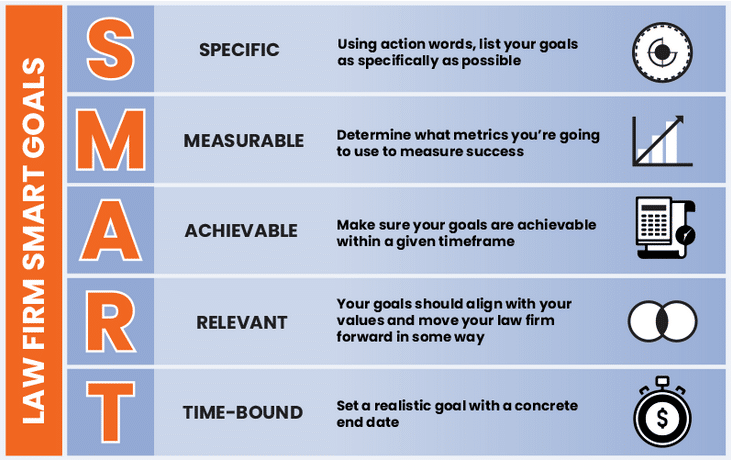
Having a dedicated marketing strategy and plan is not just beneficial — it’s essential. A well-crafted marketing strategy can significantly enhance your law firm’s visibility, attract your ideal clients, and ultimately drive growth and success.
By clearly defining your objectives and outlining the steps needed to achieve them, you can ensure that every marketing effort is purposeful and effective.
Understanding the distinction between a marketing strategy and a marketing plan is crucial and will be elaborated on within this article.
They are interdependent and must work in harmony to achieve the desired outcomes.
Understanding the distinction between a marketing strategy and a marketing plan is important for any law firm aiming to achieve its business goals through targeted marketing efforts.
Although these terms are often used interchangeably, they represent different aspects of the marketing process and serve distinct purposes.
Here’s a detailed explanation of each and how they work together to drive your firm’s success.
A marketing strategy is the overarching approach and long-term vision that guides your firm’s marketing efforts.
It is a comprehensive blueprint that defines your firm’s goals, target audience, competitive positioning, and value proposition. The strategy provides a clear direction and ensures that all marketing activities are aligned with your firm’s business objectives.
Key Components of a Marketing Strategy:
A marketing plan, on the other hand, is a detailed, tactical document that outlines the specific actions and steps your firm will take to execute its marketing strategy.
It includes timelines, budgets, and measurable objectives to ensure that the strategy is implemented effectively and efficiently.
Key Components of a Marketing Plan:
While the marketing strategy sets the direction and goals, the marketing plan provides the roadmap to achieve them.
They are interdependent and must work in harmony for your marketing efforts to be successful.
Here’s how they complement each other:
By understanding and effectively leveraging both your marketing strategy and plan, your law firm can create a cohesive and powerful marketing approach that drives growth, enhances client engagement, and achieves long-term success.
Let’s dig into what it takes to have a proper overview of your marketing strategy, so you and your team can be aligned when making actionable decisions in your marketing plan later.
The executive summary is a high-level overview of your marketing strategy, providing a snapshot of your firm’s marketing goals, key focus areas, and anticipated outcomes.
It serves as a quick reference guide for stakeholders, ensuring everyone understands the purpose and direction of the strategy.
The primary purpose of your marketing strategy is to outline a clear path for achieving your firm’s business goals through targeted marketing efforts.
This involves defining your key marketing objectives, such as increasing brand awareness, attracting new clients, retaining existing clients, and expanding into new markets.
These objectives should be specific, measurable, achievable, relevant, and time-bound (SMART) to ensure they are actionable and trackable.

Your marketing strategy should identify the key focus areas that will drive your marketing efforts.
These might include:
For each focus area, outline the anticipated outcomes, such as increased website traffic, higher client engagement rates, improved client satisfaction, or a stronger market presence.
These outcomes should align with your overall business objectives and provide a benchmark for measuring the success of your marketing efforts.
Identifying and understanding your target audience is a foundational step in developing an effective marketing strategy.
This involves segmenting your market and creating detailed profiles of your ideal clients.
Creating detailed client profiles, or personas, helps you tailor your marketing messages and tactics to resonate with your target audience.
These profiles should include:
By understanding your target audience in depth, you can develop marketing strategies that effectively address their needs, preferences, and pain points, leading to higher engagement and conversion rates.
Mapping the client journey is essential for understanding how potential clients interact with your firm from the initial awareness stage to becoming loyal advocates.
This journey typically includes several stages: Awareness, Consideration, Decision, and Advocacy.
Understanding the client journey helps you tailor your marketing tactics to each stage.
For example:
By mapping the client journey, you can ensure that your marketing efforts are aligned with the needs and behaviors of your clients at each stage, enhancing their overall experience and increasing the likelihood of conversion and advocacy.
Setting SMART goals is a critical component of any marketing strategy.
SMART goals are Specific, Measurable, Achievable, Relevant, and Time-bound. This framework ensures that your goals are clear, actionable, and trackable, providing a solid foundation for your marketing efforts.
By setting SMART goals, you can ensure that your marketing efforts are focused, efficient, and aligned with your firm’s broader objectives.
These goals provide a clear framework for measuring success and making data-driven adjustments to your strategy.
Your Unique Selling Proposition (USP) is what sets your firm apart from competitors.
It defines the unique benefits and value that your firm offers to clients, serving as the cornerstone of your marketing messages and tactics.
Your USP should be integrated into all aspects of your marketing communications, reinforcing the unique value your firm offers.
This includes:
By clearly defining and consistently promoting your USP, you can differentiate your firm from competitors and build a strong, recognizable brand that resonates with your target audience.
Conducting a thorough market analysis is crucial for understanding the dynamics of your industry, the needs of your clients, and the position of your firm in the marketplace.
This analysis informs your marketing strategy and helps you make data-driven decisions that enhance your firm’s competitive edge.
Market analysis involves researching and interpreting data about your industry, competitors, and potential clients.
It provides insights into market trends, client behavior, and competitive forces, enabling you to tailor your marketing strategy to meet the specific needs and preferences of your target audience.
Market analysis provides the data and insights needed to position your firm effectively in the marketplace.
It helps you:
By conducting a comprehensive market analysis, you can ensure that your marketing strategy is informed, relevant, and aligned with the realities of the market, ultimately leading to better decision-making and improved outcomes for your firm.
Competitive analysis is a crucial part of your marketing strategy.
It involves systematically evaluating your competitors to understand their strengths, weaknesses, and strategies, and using this information to identify opportunities and threats in the marketplace.
By conducting a thorough competitive analysis and using the insights gained to differentiate your firm, you can position your law firm more effectively in the market, attract more clients, and achieve sustained growth.
Developing a pricing and positioning strategy is essential for ensuring that your law firm is perceived as offering valuable and competitive services.
Your pricing strategy should reflect your market positioning and the value you provide to clients, while your positioning strategy should communicate your unique advantages and establish your firm’s place in the market.
Your pricing strategy should be based on a thorough understanding of your costs, client expectations, and the competitive landscape.
Here are key steps to develop an effective pricing strategy:
Your pricing strategy should complement your overall marketing strategy by reinforcing your market positioning and value proposition.
Here’s how:
Positioning involves defining how you want your firm to be perceived in the market and in the minds of your target audience.
A strong positioning strategy differentiates your firm from competitors and creates a compelling value proposition for clients.
Here are the Key Elements of a Positioning Strategy:
By developing a strong pricing and positioning strategy, you can effectively communicate your firm’s value, attract the right clients, and achieve a competitive advantage in the market.
Detailing the services your law firm provides is a critical component of your marketing strategy.
Clearly defining and communicating your service offerings helps prospective clients understand how you can meet their needs and sets the stage for effective marketing and positioning.
Your service offerings should be tailored to the needs of your target market and clearly articulated in your marketing materials.
Here’s how to effectively detail your services:
To ensure that your services meet client expectations and market demand, consider the following strategies:
Market Research: Conduct regular market research to understand the evolving needs and preferences of your target audience. Use this information to refine and expand your service offerings. Example: Surveying clients to identify emerging legal needs and adjusting your services accordingly.
Client Feedback: Gather and analyze feedback from current and past clients to identify strengths and areas for improvement in your service offerings. This helps you stay responsive to client needs and continuously enhance your services. Example: Implementing a client satisfaction survey and using the results to improve your service delivery.
Competitor Analysis: Monitor your competitors’ service offerings to identify gaps and opportunities in the market. This can help you develop unique services that differentiate your firm and meet unmet client needs. Example: Offering mediation and alternative dispute resolution services if competitors primarily focus on litigation.
Service Innovation: Stay ahead of industry trends and technological advancements by continuously innovating your services. This can involve adopting new technologies, developing specialized practice areas, or creating value-added services. Example: Utilizing legal technology to offer virtual consultations and online document management, providing clients with greater convenience and accessibility.
Clear Communication: Ensure that your service offerings are clearly communicated across all marketing channels, including your website, brochures, social media, and client consultations. This helps prospective clients quickly understand how you can help them and what makes your firm unique. Example: Creating detailed service pages on your website that highlight the benefits and process of each service.
By clearly detailing your service offerings and aligning them with client expectations and market demand, you can effectively attract and retain clients, enhance your firm’s reputation, and drive business growth.
To translate your marketing strategy into actionable steps, it’s essential to define clear and specific goals for your marketing campaigns.
These goals should be directly aligned with your strategic objectives and provide a roadmap for your marketing activities.
By defining clear, specific goals for your marketing campaigns and aligning them with your overall strategy, you can ensure that your marketing efforts are focused, effective, and capable of driving the desired results.
By defining clear, specific goals for your marketing campaigns and aligning them with your overall strategy, you can ensure that your marketing efforts are focused, effective, and capable of driving the desired results.
A compelling marketing message is essential for resonating with your target audience and conveying the unique value of your services.
Your message should be clear, consistent, and aligned with your firm’s brand and strategic objectives.

“My website continues to dominate all the top website searches in my industry and my business has grown 10-fold as a result.”
Oykhman Criminal Defence
By developing compelling marketing messages and consistently integrating your USP into all communications, you can effectively convey the unique value of your services, build stronger connections with your audience, and enhance your firm’s overall marketing effectiveness.
A well-planned marketing budget ensures that your marketing efforts are financially sustainable and aligned with your strategic goals.
Allocating a budget that maximizes ROI and supports your strategic goals involves careful planning and analysis.
Digital marketing is essential in today’s technology-driven world.
It offers precise targeting, measurable results, and often a higher ROI compared to traditional methods.
Key digital marketing channels include:
Allocating a significant portion of your budget to digital marketing can help you reach a broader audience, track performance in real-time, and adjust strategies quickly.
By carefully planning your marketing budget and balancing digital and traditional marketing spend, you can ensure that your marketing efforts are effective, targeted, and aligned with your strategic goals.
Selecting the right mix of marketing channels is critical for effectively reaching your target audience and achieving your marketing goals.
The choice of channels should be informed by your target audience’s preferences, your marketing objectives, and your budget.
To ensure that your marketing efforts are effective and delivering the desired results, it’s essential to establish a robust system for measuring performance.
This involves setting up metrics and KPIs (Key Performance Indicators) to track the success of your marketing activities and making data-driven adjustments to optimize your strategy.
A well-defined marketing strategy and a detailed marketing plan are integral to the success of any law firm.
By understanding the difference between a strategy and a plan, and effectively developing both, you can ensure that your marketing efforts are purposeful, aligned with your business objectives, and capable of driving growth.
Remember, the key to a successful marketing approach lies in continuous evaluation and refinement. By regularly reviewing your performance, staying attuned to market trends, and being flexible in your tactics, you can adapt to changing conditions and maximize the impact of your marketing efforts.
With a clear strategy and a robust plan, your law firm is well-positioned to attract and retain clients, enhance its brand presence, and achieve long-term success.
Want some help? Get in touch.
Ready to maximize your marketing budget? Fill out the contact form or call us today for a complimentary consultation. We will listen to your story, work to define your business objectives, and recommend an approach to deliver maximum ROI for your firm.
By using this website, you consent to our use of cookies in accordance with our Cookie Policy. Cookies help us enhance your browsing experience and provide personalized content. If you do not agree to our use of cookies, please adjust your browser settings accordingly.